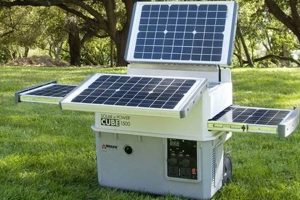Choosing between a compact, battery-powered electricity source and a fuel-driven engine for off-grid power involves weighing several key factors. A battery-powered option offers quiet operation and zero emissions, making it suitable for indoor or noise-sensitive environments like campsites. A fuel-powered alternative, conversely, provides higher sustained power output and extended runtimes, particularly beneficial for power tools or during prolonged outages. Consider a small battery-powered unit for charging electronic devices on a camping trip, contrasted with a fuel-powered unit capable of running a refrigerator during a power outage.
The ability to access electricity regardless of location or grid availability has become increasingly crucial in modern life. From emergency preparedness to recreational activities, independent power sources provide essential support for various needs. Historically, fuel-powered engines were the primary solution. However, advancements in battery technology have introduced quieter, cleaner alternatives, expanding the options available and driving innovation in power storage and delivery.
This article will delve deeper into the specific advantages and disadvantages of each option, exploring critical factors like power output, runtime, portability, cost, and maintenance requirements to guide informed decision-making.
Tips for Choosing Between a Portable Power Station and a Generator
Selecting the appropriate power solution requires careful consideration of individual needs and circumstances. The following tips offer guidance for navigating the decision-making process.
Tip 1: Evaluate Power Requirements. Determine the wattage needed to run the intended devices. Consider both peak power (the initial surge when a device starts) and running wattage (the power required for continuous operation).
Tip 2: Assess Runtime Needs. How long is power required? Battery-powered options offer limited runtimes, while fuel-powered alternatives can run significantly longer, especially with refueling.
Tip 3: Consider Noise Sensitivity. Battery-powered solutions are virtually silent, ideal for quiet environments. Fuel-powered options produce noise and may not be suitable for all locations.
Tip 4: Factor in Portability. Smaller battery-powered units excel in portability, while larger capacity options and fuel-powered units can be heavier and bulkier.
Tip 5: Analyze Fuel and Charging Options. Battery-powered units require access to an AC outlet or solar panels for recharging. Fuel-powered alternatives necessitate a continuous supply of gasoline, propane, or other appropriate fuel.
Tip 6: Budget Accordingly. Battery-powered solutions typically have a higher initial investment but lower running costs. Fuel-powered options often have lower upfront costs but ongoing fuel expenses.
Tip 7: Account for Maintenance. Fuel-powered units require regular maintenance, including oil changes and spark plug replacements. Battery-powered units require minimal maintenance.
By carefully considering these factors, consumers can select the most appropriate power solution to meet specific power needs, whether for emergencies, recreational activities, or professional use.
Ultimately, the optimal choice depends on a balance of power requirements, runtime needs, environmental considerations, and budget constraints.
1. Power Output
Power output represents a critical differentiator between portable power stations and generators. Measured in watts, this specification dictates the types and number of devices each option can power simultaneously. Generators generally offer significantly higher power outputs, ranging from several thousand watts to over ten thousand, enabling them to run power-hungry appliances like refrigerators, air conditioners, and power tools. Portable power stations, while offering increasing capacities, typically provide lower power outputs, often ranging from a few hundred watts to a couple of thousand, making them better suited for charging smaller electronics, laptops, and lights. A homeowner needing to power essential appliances during a prolonged outage would likely require the higher output of a generator, whereas an individual seeking to charge devices during a camping trip would find a portable power station sufficient.
This difference in power output stems from the distinct power generation mechanisms employed by each option. Generators utilize internal combustion engines to convert fuel into electricity, capable of sustained high-power delivery. Portable power stations, conversely, rely on stored battery power, limiting their maximum output and duration, although advancements in battery technology continually push these boundaries. Choosing between the two hinges on accurately assessing power needs. Overloading a portable power station can lead to shutdowns, while selecting an underpowered generator may fail to run necessary equipment. Understanding the relationship between wattage requirements of intended devices and the output capabilities of each option is essential for practical application.
Understanding power output is fundamental to effectively selecting between a portable power station and a generator. Matching power needs with the appropriate power source ensures optimal performance and prevents equipment damage. While generators offer higher output for demanding applications, portable power stations provide a quieter, cleaner alternative for less power-intensive scenarios. Careful consideration of power output alongside other factors such as runtime, noise levels, and portability provides a comprehensive basis for informed decision-making.
2. Runtime
Runtime, a crucial factor in the portable power station versus generator debate, signifies the duration a power source can operate before requiring refueling or recharging. This operational timeframe significantly influences the suitability of each option for various applications, from emergency power supply to recreational activities. Understanding runtime characteristics is essential for informed decision-making.
- Fuel Capacity and Battery Size
Runtime in generators is directly related to fuel tank capacity and fuel efficiency. Larger tanks generally translate to longer runtimes, while fuel efficiency dictates how long a given volume of fuel lasts. Portable power stations, conversely, depend on battery capacity, measured in watt-hours (Wh) or ampere-hours (Ah). Higher capacity batteries offer longer runtimes. For instance, a generator with a large fuel tank can run for hours, even days, while a portable power station with a high-capacity battery might offer several hours of power depending on the load.
- Power Consumption of Connected Devices
The power consumption of connected devices directly influences runtime. Higher power demands deplete fuel or battery reserves more quickly, shortening the operational period. A generator powering several appliances simultaneously will consume fuel faster than one powering a single lightbulb. Similarly, a portable power station charging a laptop will deplete its battery faster than if it were powering a small fan. Therefore, accurately estimating power requirements is essential for predicting runtime.
- Environmental Factors
External factors, such as ambient temperature, can influence runtime. Extreme temperatures can impact battery performance in portable power stations, potentially reducing their operational duration. Generators, while less susceptible to temperature fluctuations, can experience performance variations depending on altitude and air density. Understanding these environmental influences ensures realistic runtime expectations.
- Continuous vs. Intermittent Use
The pattern of power usage, whether continuous or intermittent, also affects runtime. Continuous operation, like powering a refrigerator, drains power sources more consistently than intermittent use, like charging a phone. Generators are generally designed for sustained operation, while portable power stations can handle both continuous and intermittent loads within their power output and capacity limits.
Ultimately, selecting the appropriate power source requires careful consideration of runtime requirements and how they align with the capabilities of each option. Generators typically offer extended runtimes for prolonged power needs, whereas portable power stations provide convenient, shorter-duration power for less demanding applications. A comprehensive understanding of runtime characteristics contributes significantly to informed decision-making in the context of portable power stations versus generators.
3. Portability
Portability represents a pivotal factor when choosing between a portable power station and a generator, particularly when the intended use involves transport and maneuverability. Weight, size, and integrated features contribute significantly to the overall portability of each option, impacting ease of use in various scenarios, from outdoor adventures to emergency situations. This section explores the multifaceted nature of portability within the context of portable power stations and generators.
- Weight and Size
Physical dimensions and weight directly influence portability. Portable power stations generally offer a more compact and lightweight solution compared to generators, especially for equivalent power outputs. This advantage stems from their integrated battery systems, eliminating the need for separate fuel tanks and heavier engine components. Smaller, lighter power stations are easily carried, transported in vehicles, and positioned in various locations. Generators, while available in various sizes, tend to be bulkier and heavier due to their engines and fuel requirements, potentially limiting their portability, especially in challenging terrains or confined spaces.
- Integrated Handles and Wheels
Design features like integrated handles and wheels enhance portability. Many portable power stations incorporate ergonomic handles and sometimes wheels for convenient transport, even over uneven surfaces. While some smaller generators also offer similar features, larger models often require additional equipment or assistance for movement. The presence of these features significantly affects ease of use and overall portability.
- Form Factor and Design
The overall form factor and design contribute to portability. Portable power stations typically feature compact, rectangular designs that optimize space utilization and facilitate packing. Generators, often housed in metal frames, can be more cumbersome to store and transport, especially in vehicles with limited cargo space. A streamlined design enhances portability and ease of integration into various environments.
- Placement Flexibility
Portability directly influences placement flexibility. The compact nature and quiet operation of portable power stations allow for indoor use and placement in confined spaces, such as tents or RVs, expanding their versatility. Generators, due to noise and exhaust emissions, typically require outdoor placement, potentially limiting their usability in certain situations. The ability to position a power source conveniently and safely enhances its practicality and overall value.
In conclusion, portability considerations play a significant role in selecting between a portable power station and a generator. Evaluating factors such as weight, size, integrated features, and form factor helps determine the most suitable option for specific applications. While portable power stations generally excel in portability for their compact designs, the higher power output and extended runtime of generators might outweigh portability limitations for certain users. Ultimately, the optimal choice depends on a balanced assessment of power needs, runtime requirements, and portability constraints, ensuring the selected power source aligns seamlessly with the intended use case.
4. Noise Levels
Noise levels represent a critical distinguishing feature between portable power stations and generators, significantly influencing their suitability for various environments and applications. The contrast in operational noise stems from the fundamental differences in their power generation mechanisms. This distinction has practical implications for users, particularly in noise-sensitive environments like campsites, residential areas, or during outdoor events. Understanding the noise profiles of each option is essential for making informed decisions.
- Operational Noise Sources
Generators, relying on internal combustion engines, inherently produce noise from engine operation, exhaust, and cooling fans. This noise can be substantial, often exceeding 70 decibels, comparable to the sound of a vacuum cleaner or busy traffic. Portable power stations, conversely, operate silently due to their battery-based power delivery. This silent operation makes them ideal for indoor use, quiet environments, and situations where noise pollution is a concern, such as wildlife observation or film production.
- Decibel Levels and Human Perception
The decibel (dB) scale quantifies sound intensity. Generators often operate within the 70-80 dB range, potentially reaching higher levels depending on the model and load. Prolonged exposure to such noise levels can be disruptive and even harmful to hearing. Portable power stations, with their near-silent operation, typically register below 50 dB, similar to a quiet conversation. This substantial difference in decibel levels significantly impacts user comfort and environmental compatibility.
- Impact on Surrounding Environments
Noise pollution from generators can disrupt surrounding environments, affecting wildlife, neighbors, and overall tranquility. In campsites or residential areas, generator noise can be a nuisance. Portable power stations, being silent, minimize environmental impact, preserving the peace and quiet of natural settings or shared spaces. This consideration is crucial for responsible and considerate power usage.
- Mitigation Strategies for Generator Noise
Various strategies exist to mitigate generator noise, including sound-dampening enclosures, exhaust mufflers, and strategic placement away from noise-sensitive areas. However, these measures can add cost and complexity. The inherent silence of portable power stations eliminates the need for such interventions, offering a simpler, quieter solution from the outset.
In summary, noise levels play a crucial role in the portable power station versus generator decision. Generators, while offering high power output, introduce noise pollution, a significant drawback in many scenarios. Portable power stations, with their silent operation, provide a more environmentally friendly and user-friendly alternative for noise-sensitive applications. Carefully weighing noise considerations against power requirements and runtime needs ensures the selected power source aligns with the specific demands of the intended use case.
5. Fuel/Charging
Fueling and charging requirements represent a fundamental distinction between portable power stations and generators, directly impacting their operational costs, logistical considerations, and environmental footprint. This core difference stems from the distinct energy storage and conversion mechanisms employed by each technology. Understanding these fuel and charging dynamics is crucial for selecting the appropriate power solution for specific needs and circumstances. Generators, relying on internal combustion engines, require a continuous supply of fuel, typically gasoline, propane, or diesel. This necessitates fuel storage, transportation, and handling, introducing ongoing costs and potential environmental concerns associated with fuel combustion emissions. Portable power stations, conversely, utilize rechargeable batteries, drawing power from AC outlets or, increasingly, solar panels. This eliminates the need for fuel logistics but introduces charging time considerations and dependence on external power sources or sunlight availability.
The practical implications of these differing fuel and charging requirements are substantial. For extended operations or remote locations lacking grid access, generators offer a self-contained power solution, albeit with the ongoing need for refueling. A construction crew operating power tools at a remote site, for example, benefits from the extended runtime offered by a generator. Portable power stations, while offering limited runtime on a single charge, provide a cleaner, quieter alternative for shorter-duration applications, such as camping trips or powering devices during short-term power outages. Recharging from solar panels further enhances their off-grid capabilities, aligning with sustainable energy practices. The choice between a generator and a portable power station depends heavily on balancing power needs, runtime expectations, access to fuel or charging infrastructure, and environmental considerations. A careful assessment of these factors informs optimal power solution selection for specific use cases.
In summary, the fuel and charging characteristics of portable power stations and generators represent a crucial decision point. Generators offer fuel-driven independence for extended operation but introduce logistical and environmental considerations. Portable power stations, relying on rechargeable batteries, provide a cleaner, quieter alternative but necessitate access to charging infrastructure or solar panels. Understanding these fundamental differences is paramount for effective power solution selection, ensuring the chosen technology aligns seamlessly with the demands of the intended application, whether for emergency preparedness, recreational activities, or professional use.
Frequently Asked Questions
This FAQ section addresses common inquiries regarding portable power stations and generators, providing concise and informative responses to facilitate informed decision-making.
Question 1: What are the primary differences between a portable power station and a generator?
Portable power stations utilize rechargeable batteries to store and deliver electricity, offering quiet and emission-free operation. Generators, conversely, employ internal combustion engines to generate electricity, providing higher power output and extended runtimes but producing noise and exhaust fumes.
Question 2: Which option is more suitable for emergency preparedness?
Both options can serve emergency needs, but their suitability depends on specific requirements. Portable power stations are ideal for powering essential electronics and small appliances during short-term outages. Generators are better suited for prolonged outages requiring higher power output for appliances like refrigerators or sump pumps.
Question 3: What are the typical runtimes for each power source?
Generator runtimes depend on fuel tank capacity and load, often ranging from several hours to multiple days with refueling. Portable power station runtimes are determined by battery capacity and power consumption of connected devices, typically ranging from a few hours to over a day for larger capacity units.
Question 4: What are the respective maintenance requirements?
Generators require regular maintenance, including oil changes, spark plug replacements, and air filter cleaning. Portable power stations require minimal maintenance, primarily involving proper battery care and occasional cleaning.
Question 5: Which option is more environmentally friendly?
Portable power stations offer a cleaner energy solution with zero emissions during operation. Generators produce exhaust fumes, contributing to air pollution. Solar-powered charging further enhances the environmental friendliness of portable power stations.
Question 6: What are the typical costs associated with each option?
Portable power stations generally have a higher initial purchase price but lower running costs due to the absence of fuel expenses. Generators typically have lower upfront costs but incur ongoing fuel and maintenance expenses.
Careful consideration of individual power needs, budget constraints, and environmental priorities guides the selection process. Understanding the unique characteristics of each power source empowers informed decision-making for various applications.
For further inquiries or specific application scenarios, consulting with a power solutions expert is recommended.
Portable Power Station vs Generator
The “portable power station vs generator” dilemma represents a crucial decision point for individuals seeking reliable off-grid power. This exploration has highlighted the key differentiators between these two technologies, encompassing power output, runtime, portability, noise levels, and fuel/charging considerations. Generators offer robust power output and extended runtimes, ideal for demanding applications and prolonged outages, but introduce noise and emissions. Portable power stations provide a cleaner, quieter alternative, excelling in portability and ease of use, though limited by battery capacity and output. Ultimately, the optimal choice hinges on a comprehensive evaluation of individual power needs, environmental priorities, and budgetary constraints.
As technology continues to advance, both portable power stations and generators are likely to see improvements in efficiency, capacity, and sustainability. Consumers are encouraged to thoroughly research available options and align their selection with specific use cases. Choosing the right power solution empowers individuals with energy independence and resilience, whether for recreational pursuits, emergency preparedness, or professional applications. A well-informed decision ensures access to reliable power when and where it is needed most.






